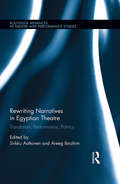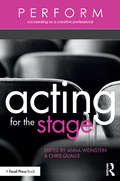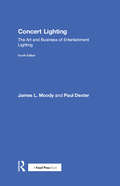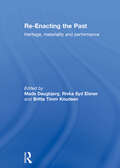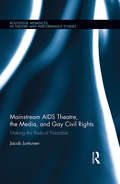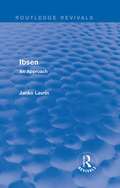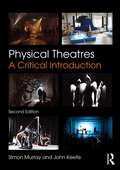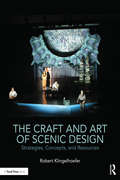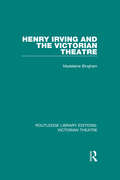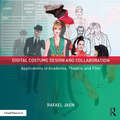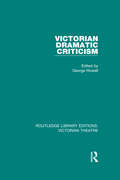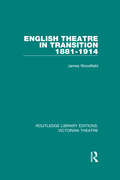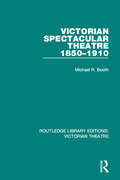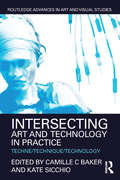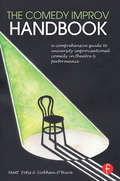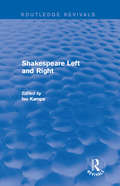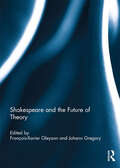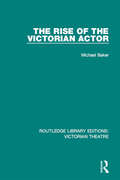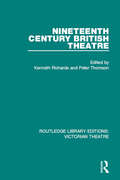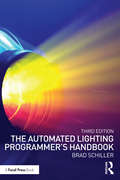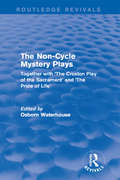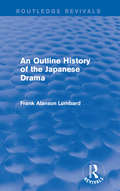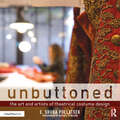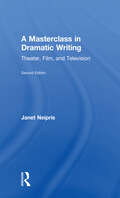- Table View
- List View
Rewriting Narratives in Egyptian Theatre: Translation, Performance, Politics (Routledge Advances in Theatre & Performance Studies)
by Sirkku Aaltonen Areeg IbrahimThis study of Egyptian theatre and its narrative construction explores the ways representations of Egypt are created of and within theatrical means, from the 19th century to the present day. Essays address the narratives that structure theatrical, textual, and performative representations and the ways the rewriting process has varied in different contexts and at different times. Drawing on concepts from Theatre and Performance Studies, Translation Studies, Cultural Studies, Postcolonial Studies, and Diaspora Studies, scholars and practitioners from Egypt and the West enter into dialogue with one another, expanding understanding of the different fields. The articles focus on the ways theatre texts and performances change (are rewritten) when crossing borders between different worlds. The concept of rewriting is seen to include translation, transformation, and reconstruction, and the different borders may be cultural and national, between languages and dramaturgies, or borders that are present in people’s everyday lives. Essays consider how rewritings and performances cross borders from one culture, nation, country, and language to another. They also study the process of rewriting, the resulting representations of foreign plays on stage, and representations of the Egyptian revolution on stage and in Tahrir Square. This assessment of the relationship between theatre practices, exchanges, and rewritings in Egyptian theatre brings vital coverage to an undervisited area and will be of interest to developments in theatre translation and beyond.
Acting for the Stage (PERFORM)
by Anna Weinstein Chris QuallsActing for the Stage is a highly accessible guide to the business of theater acting, written for those interested in pursuing acting as a profession. This book is a collection of essays by and interviews with talented artists and businesspeople who have built successful careers in the theater; it’s a goldmine of career advice that might take years to find on your own. Herein, the myths around professional acting are dispelled, and the mysteries revealed. Acting for the Stage illuminates practical strategies to help you build a life as a theater professional and find financial rewards and creative fulfillment in the process. Contains essays by and interviews with working stage actors, acting coaches, directors, writers, and agents. Features discussions on selecting a graduate school program, choosing acting classes and workshops, making the most out of your showcase, landing an agent, networking and promoting yourself, and the business of casting. Covers issues of money management, balancing the highs and lows of the profession, finding work to nourish your acting career, and building your creative team and support network.
Concert Lighting: The Art and Business of Entertainment Lighting
by James Moody Paul DexterConcert Lighting: Tools, Techniques, Art, and Business Fourth Edition provides readers with an updated look at how to succeed in the complex world of concert lighting design and technology. The authors have reorganized the book into three comprehensive and thoroughly revised sections, covering history, equipment and technology, and design, and containing new information on LED technology, pixel mapping, projection options, media servers, automated lighting, solutions for moving lights, DMX, and Ethernet problems, and designer communication and collaboration. This book also explores the cross-media use of concert lighting techniques in film, video, theatre, and the corporate world, highlighted with advice from master designers such as Bruce Rodgers, Cosmo Wilson, and Sarah Landau. From securing precious contracts to knowing the best equipment to use to design a show, Concert Lighting covers everything a designer needs to know about working in the touring industry.
Re-Enacting the Past: Heritage, Materiality and Performance
by Mads Daugbjerg, Rivka Syd Eisner and Britta Timm KnudsenWhat is re-enactment and how does it relate to heritage? Re-enactments are a ubiquitous part of popular and memory culture and are of growing importance to heritage studies. As concept and practice, re-enactments encompass a wide range of forms: from the annual ‘Viking Moot’ festival in Denmark drawing thousands of participants and spectators, to the (re)staged war photography of An-My Lê, to the Titanic Memorial Cruise commemorating the centennial of the ill-fated voyage, to the symbolic retracing of the Berlin Wall across the city on 9 November 2014 to mark the 25th anniversary of its toppling.Re-enactments involve the sensuousness of bodily experience and engagement, the exhilarating yet precarious combination of imagination with ‘historical fact’, in-the-moment negotiations between and within temporalities, and the compelling drive to re-make, or re-presence, the past. As such, re-enactments present a number of challenges to traditional understandings of heritage, including taken-for-granted assumptions regarding fixity, conservation, originality, ownership and authenticity. Using a variety of international, cross-disciplinary case studies, this volume explores re-enactment as practice, problem, and/or potential, in order to widen the scope of heritage thinking and analysis toward impermanence, performance, flux, innovation and creativity.This book was originally published as a special issue of the International Journal of Heritage Studies.
Mainstream AIDS Theatre, the Media, and Gay Civil Rights: Making the Radical Palatable (Routledge Advances in Theatre & Performance Studies)
by Jacob JuntunenThis book demonstrates the political potential of mainstream theatre in the US at the end of the twentieth century, tracing ideological change over time in the reception of US mainstream plays taking HIV/AIDS as their topic from 1985 to 2000. This is the first study to combine the topics of the politics of performance, LGBT theatre, and mainstream theatre’s political potential, a juxtaposition that shows how radical ideas become mainstream, that is, how the dominant ideology changes. Using materialist semiotics and extensive archival research, Juntunen delineates the cultural history of four pivotal productions from that period—Larry Kramer’s The Normal Heart (1985), Tony Kushner’s Angels in America (1992), Jonathan Larson’s Rent (1996), and Moises Kaufman’s The Laramie Project (2000). Examining the connection between AIDS, mainstream theatre, and the media reveals key systems at work in ideological change over time during a deadly epidemic whose effects changed the nation forever. Employing media theory alongside nationalism studies and utilizing dozens of reviews for each case study, the volume demonstrates that reviews are valuable evidence of how a production was hailed by society’s ideological gatekeepers. Mixing this new use of reviews alongside textual analysis and material study—such as the theaters’ locations, architectures, merchandise, program notes, and advertising—creates an uncommonly rich description of these productions and their ideological effects. This book will be of interest to scholars and students of theatre, politics, media studies, queer theory, and US history, and to those with an interest in gay civil rights, one of the most successful social movements of the late twentieth century.
Ibsen: An Approach (Routledge Revivals #No. 18)
by Janko LavrinThis book, first published in 1950, could best be described as a combination of literary, psychological and social criticism. Considerable space is allotted to the personal inner drama of Ibsen, which provides not only a clue to his art but shows how most of his themes inevitably grew out of the other. The author also explores some of those factors which make Ibsen of interest to the generation that were facing the social and spiritual havoc of the post-war period. This book will be of interest to students of literature and theatre.
Physical Theatres: A Critical Introduction
by Simon Murray John KeefeThis new edition of Physical Theatres: A Critical Introduction continues to provide an unparalleled overview of non-text-based theatre, from experimental dance to traditional mime. It synthesizes the history, theory and practice of physical theatres for students and performers in what is both a core area of study and a dynamic and innovative aspect of theatrical practice. This comprehensive book: traces the roots of physical performance in classical and popular theatrical traditions looks at the Dance Theatre of DV8, Pina Bausch, Liz Aggiss and Jérôme Bel examines the contemporary practice of companies such as Théatre du Soleil, Complicite and Goat Island focuses on principles and practices in actor training, with reference to figures such as Jacques Lecoq, Lev Dodin, Philippe Gaulier, Monika Pagneux, Etienne Decroux, Anne Bogart and Joan Littlewood. Extensive cross references ensure that Physical Theatres: A Critical Introduction can be used as a standalone text or together with its companion volume, Physical Theatres: A Critical Reader, to provide an invaluable introduction to the physical in theatre and performance. New to this edition: a chapter on The Body and Technology, exploring the impact of digital technologies on the portrayal, perception and reading of the theatre body, spanning from onstage technology to virtual realities and motion capture; additional profiles of Jerzy Grotowski, Wrights and Sites, Punchdrunk and Mike Pearson; focus on circus and aerial performance, new training practices, immersive and site-specific theatres, and the latest developments in neuroscience, especially as these impact on the place and role of the spectator.
The Craft and Art of Scenic Design: Strategies, Concepts, and Resources
by Robert KlingelhoeferThe Craft and Art of Scenic Design: Strategies, Concepts, and Resources explores how to design stage scenery from a practical and conceptual perspective. Discussion of conceptualizing the design through script analysis and research is followed by a comprehensive overview of execution: collaboration with directors and other designers, working with spaces, developing an effective design process, and the aesthetics of stage design. This book features case studies, key words, tip boxes, definitions, and chapter exercises. Additionally, it provides advice on portfolio and career development, contracts, and working with a union. This book was written for university-level Scenic Design courses.
Henry Irving and The Victorian Theatre (Routledge Library Editions: Victorian Theatre #2)
by Madeleine BinghamOriginally published in 1978. Henry Irving achieved an astounding success in Britain and America as an actor; yet he lacked good looks, had spindly legs, and did not have a good voice. He said so himself. Today Irving is regarded as the archetype of the old-time actor, but in his own time he was regarded as a great theatrical innovator. Even Bernard Shaw, who attacked him pitilessly, even unto death, called him ‘modern’ when he first saw him act. Irving, the man, with his tenacious, obsessive talent, his human limitations and weaknesses, and his ephemeral glory is brought most sympathetically to life in this biography. It is written from contemporary sources, and from criticisms, lampoons, caricatures and gossip columns. If Irving reflected certain aspects of his age, this book underlines the Victorian ethic to which he appealed and the backcloths against which it was set – the extraordinary lavishness of the Lyceum productions and the incredible extravagance of social entertaining. Not the least absorbing aspect of this biography is the fascinating account of the long partnership between Irving and Ellen Terry, still in many respects an enigmatic one, but here portrayed with lively insight into character combined with understanding and deep knowledge of the social and theatrical context of the Victorian age.
Digital Costume Design and Collaboration: Applications in Academia, Theatre, and Film
by Rafael JaenDigital Costume Design and Collaboration gives in-depth instruction on how to draw, render, and fully design costumes using online tools and software. Grounded in the use of Photoshop, the book explains the process of building a costume design from scratch, including information on digital tools and painting techniques. The book demonstrates how to utilize social media, such as Flickr and Pinterest, to compile research; how to create user-friendly web based slide shows; and how to archive digital files for portfolios and personal websites. It also demonstrates how to organize spec sheets, plots and inventories using Google Docs for easy editing and Dropbox for easy file sharing. A companion YouTube channel featuring video tutorials of exercises and applications compliments the book.
Victorian Dramatic Criticism (Routledge Library Editions: Victorian Theatre #5)
by George RowellOriginally published in 1971. The Victorian Age was one of popular theatre and increasingly popular journalism. One manifestation of this journalism was the emergence of the dramatic critic from the anonymity and brevity which had previously characterized periodical treatment of the theatre. If Victorian theatre is regarded as existing essentially thirty years before Victoria acceded and continuing until the outbreak of war in 1914, the names of Lamb, Leigh Hunt and Hazlitt at one end, and of Beerbohm and MacCarthy at the other, can be added to a list that includes Lewes, James, Archer, Walkley, Shaw and Montague. All these writers, and others less famous, are represented in this selection. By selecting the articles on the basis of the play in performance, rather than the play as literature, and by arranging them according to various aspects of the theatrical process, this book builds up a skilful and lively picture of the contemporary theatre at work, in the words of its leading commentators. The anthology successfully conveys the qualities of abundance and vitality to characteristic of Victorian theatre.
English Theatre in Transition 1881-1914 (Routledge Library Editions: Victorian Theatre #6)
by James WoodfieldOriginally published in 1984. The turn of the nineteenth and twentieth centuries was a time of considerable change in the English theatre. Victorian attitudes were shocked or shattered by the new drama of Ibsen; the major figure of George Bernard Shaw dominated the period; theatre censorship was the subject of a long and furious contest; and staging conventions changed from the spectacular stylings of Irving and Beerbohm Tree to the masking and statuesque styles of Isadora Duncan and the inner realism of Stanislavsky. This book traces the activities of the leading figures in the English theatre, notably William Archer who introduced Ibsen to this country and who became one of the main promoters of the idea of a National Theatre. Other personalities discussed include Harley Granville Barker, particularly his association with Shaw at the Court Theatre and his part in campaigns against censorship and for changes in the staging of Shakespeare, and Edward Gordon Craig, whose rebellion against the Victorian theatre took and anti-realist direction. This is a stimulating account of the background to the modern English theatre which can only increase appreciation of its standard and variety.
Victorian Spectacular Theatre 1850-1910 (Routledge Library Editions: Victorian Theatre #3)
by Michael R. BoothOriginally published in 1981. This study concentrates on one aspect of Victorian theatre production in the second half of the nineteenth century – the spectacular, which came to dominate certain kinds of production during that period. A remarkably consistent style, it was used for a variety of dramatic forms, although surrounded by critical controversy. The book considers the theories and practice of spectacle production as well as the cultural and artistic movements that created the favourable conditions in which spectacle could dominate such large areas of theatre for so many years. It also discusses the growth of spectacle and the taste of the public for it, examining the influence of painting, archaeology, history, and the trend towards realism in stage production. An explanation of the working of spectacle in Shakespeare, pantomime and melodrama is followed by detailed reconstructions of the spectacle productions of Irving’s Faust and Beerbohm Tree’s King Henry VIII.
Intersecting Art and Technology in Practice: Techne/Technique/Technology (Routledge Advances in Art and Visual Studies)
by Camille C Baker and Kate SicchioThis book focuses on the artistic process, creativity and collaboration, and personal approaches to creation and ideation, in making digital and electronic technology-based art. Less interested in the outcome itself – the artefact, artwork or performance – contributors instead highlight the emotional, intellectual, intuitive, instinctive and step-by-step creation dimensions. They aim to shine a light on digital and electronic art practice, involving coding, electronic gadgetry and technology mixed with other forms of more established media, to uncover the practice-as-research processes required, as well as the collaborative aspects of art and technology practice.
The Comedy Improv Handbook: A Comprehensive Guide to University Improvisational Comedy in Theatre and Performance
by Matt Fotis Siobhan O'HaraThe Comedy Improv Handbook: A Comprehensive Guide to University Improvisational Comedy in Theatre and Performance is a one-stop resource for both improv teachers and students, covering improv history, theory, maxims, exercises, games, and structures. You will learn the necessary skills and techniques needed to become a successful improviser, developing a basic understanding of the history of improvisation and its major influences, structures, and theories. This book also addresses issues associated with being a college improviser – like auditions, rehearsals, performances, and the dynamics of improv groups.
Shakespeare Left and Right (Routledge Revivals)
by Ivo KampsShakespeare Left and Right brings together critics, strikingly different in their politics and methodologies, who are acutely aware of the importance of politics on literary practice and theory. Should, for example, feminist criticism be subjected to a critique by voices it construes as hostile to its political agenda? Is it possible to present a critique of feminist criticism without implicitly impeding its politics? And, in the light of recent political events should the Right pronounce the demise of Marxism as a social science and interpretive tool? The essays in Shakespeare Left and Right, first published in 1991, present a tug of war about ideology, acted out over the body of Shakespeare. Part One focuses on the challenge thrown down by Richard Levin's widely discussed "Feminist Thematics and Shakespearean Tragedy". Part Two considers these issues in relation to critical practice and the reading of specific plays. This book should be of interest to undergraduates and academics interested in Shakespeare studies.
Shakespeare and the Future of Theory
by François-Xavier Gleyzon and Johann GregoryShakespeare and the Future of Theory convenes internationally renowned Shakespeare scholars, and scholars of the Early Modern period, and presents, discusses, and evaluates the most recent research and information concerning the future of theory in relation to Shakespeare’s corpus. Original in its aim and scope, the book argues for the critical importance of thinking Shakespeare now, and provides extensive reflections and profound insights into the dialogues between Shakespeare and Theory. Contributions explore Shakespeare through the lens of design theory, queer theory, psychoanalysis, Derrida and Foucault, amongst others, and offer an innovative interdisciplinary analysis of Shakespeare’s work. This book was originally published as two special issues of English Studies.
The Rise of the Victorian Actor (Routledge Library Editions: Victorian Theatre #1)
by Michael BakerOriginally published in 1978. Between 1830 and 1890 the English theatre became recognisably modern. Standards of acting and presentation improved immeasurably, new playwrights emerged, theatres became more comfortable and more intimate and playgoing became a national pastime with all classes. The actor’s status rose accordingly. In 1830 he had been little better than a social outcast; by 1880 he had become a member of a skilled, relatively well-paid and respected profession which was attracting new recruits in unprecedented numbers. This is a social history of Victorian actors which seeks to show how wider social attitudes and developments affected the changing status of acting as a profession. Thus the stage’s relationship with the professional world and the other arts is dealt with and is followed by an assessment of the moral and religious background which played so decisive a part in contemporary attitudes to actors. The position of actresses in particular is given special consideration. Many non-theatrical sources are used here and there is a survey of salaries and working conditions in the theatre to show how the rising social status of the actor was matched by changes in his theatrical standing. A novel area of study is covered in tracing the changing social composition of the acting profession over the period and in exploring the case-histories of three generations of performers.
Nineteenth Century British Theatre (Routledge Library Editions: Victorian Theatre)
by KENNETH RICHARDS AND PETER THOMSONOriginally published in 1971. Nineteenth-century theatre in England has been greatly neglected, although serious study would reveal that the roots of much modern drama are to be found in the experiments and extravagancies of the nineteenth-century stage. The essays collected here cover a range of topics within the world of Victorian theatre, from particular actors to particular theatres; from farce to Byron’s tragedies, plus a separate section about Shakespearean productions.
The Automated Lighting Programmer's Handbook
by Brad SchillerThis guide helps lighting designers with the creative and operational challenges they face in their rapidly evolving industry. Providing respected and clear coverage of the process of programming automated lighting fixtures, the author brings the designer from basic principles to preproduction preparations. Concepts, procedures, and guidelines to ensure a successful production are covered as well as troubleshooting, much needed information on work relationships, and technology including LED lighting, console networking, digital lighting, and more. Chapters are peppered with advice and war stories from some of the most prominent lighting designers of today.
The Non-Cycle Mystery Plays: Together with 'The Croxton Play of the Sacrament' and 'The Pride of Life' (Routledge Revivals)
by Osborn WaterhouseBetween the beginning of the tenth and the end of the sixteenth centuries, in all parts of Great Britain from Aberdeen to Cornwall, performances of liturgical and mystery plays are on record. This book, first published in 1909, is a collection of early-English religious plays with a detailed introduction written by the editor Osborn Waterhouse. The Non-Cycle Mystery Plays will be of interest to students of drama, performance and theatre studies.
An Outline History of the Japanese Drama (Routledge Revivals)
by Frank Alanson LombardStudents of international drama are turning more and more to the study of Japanese drama, desirous to know to what extent its development duplicates or differs from the evolution of drama in other countries. Stimulated by the colour, originality, power, and poetry, they are interested to know more. This title, first published in 1928, traces the general development of the drama of the Japanese. This book will be of interest to students of drama, theatre studies and Asian Studies.
Unbuttoned: The Art and Artists of Theatrical Costume Design
by Shura PollatsekUnbuttoned: The Art and Artists of Theatrical Costume Design documents the creative journey of costume creation from concept to performance. Each chapter provides an overview of the process, including designing and shopping; draping, cutting, dyeing, and painting; and beading, sewing, and creating embellishments and accessories. This book features interviews with practitioners from Broadway and regional theatres to opera and ballet companies, offering valuable insights into the costume design profession. Exceptional behind-the-scenes photography illustrates top costume designers and craftspeople at work, along with gorgeous costumes in progress.
Unbuttoned: The Art and Artists of Theatrical Costume Design
by Shura PollatsekUnbuttoned: The Art and Artists of Theatrical Costume Design documents the creative journey of costume creation from concept to performance. Each chapter provides an overview of the process, including designing and shopping; draping, cutting, dyeing, and painting; and beading, sewing, and creating embellishments and accessories. This book features interviews with practitioners from Broadway and regional theatres to opera and ballet companies, offering valuable insights into the costume design profession. Exceptional behind-the-scenes photography illustrates top costume designers and craftspeople at work, along with gorgeous costumes in progress.
A Masterclass in Dramatic Writing: Theater, Film, and Television
by Janet NeiprisA Masterclass in Dramatic Writing addresses all three genres of dramatic writing - for theatre, film and TV - in a comprehensive, one-semester, 14-week masterclass for the dramatic writer.This book is tightly focused on the practical outcome of completing a first draft and first rewrite of a dramatic work, drawing on Professor Janet Neipris’ many years of experience as the head of Dramatic Writing at NYU Tisch. The fourteen chapters, organized like a semester, take the reader week-by-week and step-by-step through writing a first draft of an original play, screenplay, or TV pilot, while also teaching the core principles of dramatic writing. Chapters include Beginnings, Creating Complex Characters, Dialogue, Escalating Conflicts, Endings, Checkpoints, Comedy, and Adaptation, and there are Weekly Exercises and progressive Assignments.This book is perfect for professional writers, teachers, and students of dramatic writing, as well as anyone who wants to complete their first dramatic work.An award-winning playwright and Professor of Dramatic Writing at NYU, Janet Neipris has written for Screen and Television. She has also taught dramatic writers at UCLA and in China, Australia, Indonesia, South Africa, Italy, and in the UK at Oxford, CSSD, University of Birmingham, and the University of East Anglia. Previous publications include To Be A Playwright (Routledge 2006). Janet Neipris’s plays and letters are in the Theatre Collection of Harvard University’s Houghton Library. For more, see www.janetneipris.com.
